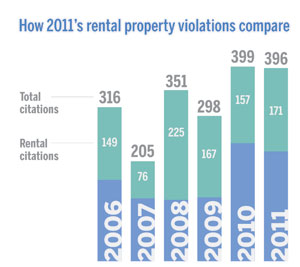Kent’s building code violations barely changed from 2010

March 29, 2012
Rental properties in Kent accounted for the majority of the city’s private property code violations for the fourth year in a row.
Of the 396 violations in 2011, 43 percent came from rental properties, with overgrown vegetation and illegal use at the top of the list.
No major student apartments appeared on the violations list, with most of the rental properties being houses, said Suzanne Robertson, administrative assistant to the city manager.
“Right now our ordinance covers exterior property maintenance,” said Troy Loomis, the code enforcement officer for Kent. He said he can’t enter homes to inspect interior maintenance without permission from the owner.
Loomis said he gets complaints from neighbors, or observes violations himself. Once he gets a complaint from a citizen, he goes out to the site to verify the violation. He takes pictures from the sidewalk, street or a neighbor’s yard if he has been granted permission. He is not allowed to step on the property that has the alleged violation.
If he is able to see the violation, he documents it and writes a warning letter that specifies to the property owner which city ordinance was violated. Loomis gives the violator 10 days to comply. If the property owner refuses, Loomis issues a fine, which starts at $100.
Of the property owners violating building codes, 27 percent were cited in previous years. Only 20 percent of the rental properties were repeat violators. Because one owner can own multiple properties, it’s possible for the owner to be cited repeatedly without each property being cited, Robertson said.
Loomis said at least 75 percent of property owners take care of the violation in a timely manner.
“If people call, I try to be flexible with them to a point,” Loomis said. “I understand there are certain circumstances and weather conditions and we try to work with people as much as we can.”
Loomis said he makes a point to enforce overgrown vegetation (high grass and weed problems), which has been a common issue over the past six years, according to the summary of 2011 code violations.
The violations have decreased in the last three or four years because Loomis’ office purchased yard tools such as leaf blowers, rakes, shovels and lawn mowers that residents can use for free.
“It boiled down to the residents not having lawn mowers, so we bought some tools to assist them and it’s been pretty effective,” Loomis said.
There is also sometimes a miscommunication between the landlord and tenants about whose responsibility it is to maintain the property. Students often leave in May and the next tenant doesn’t come until August. Even if the students have a lease until the end of July, it’s ultimately the landlord’s responsibility to keep the property maintained, Loomis said.
Illegal use violations comprised the second highest total violations, accounting for 29 percent of all citations. It includes using property as boarding houses, a commercially-zoned property being used as a residential property, and vice versa, Robertson said.
If a property is designated as a single-family home, no more than two unrelated people can occupy that address. Neighbors often report this problem because excessive trash or lack of parking becomes problematic when too many people occupy a property, Loomis said.
Land owners can find the ordinances on the city of Kent’s website. There are also copies at the University Library and the Kent Free Library.
Contact Lindsy Neer at [email protected] and Rachel Hagenbaugh at [email protected].
























